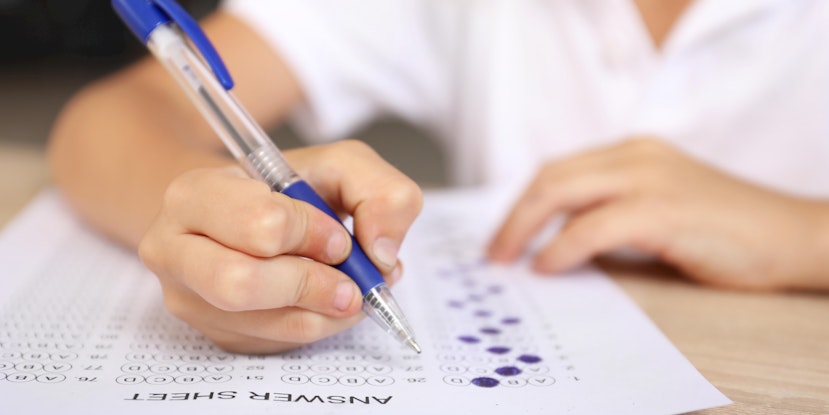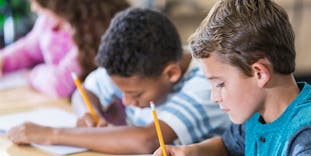How to Pass the NWEA 5th Grade MAP Test in 2026
Updated January 29, 2024
- What Is the NWEA 5th Grade MAP Test?
- How Is the NWEA 5th Grade MAP Test Used?
- How Do You Take the NWEA 5th Grade MAP Test?
- Are There Different Types of NWEA 5th Grade MAP Tests?
- When Do You Sit the NWEA 5th Grade MAP Test?
- Is the NWEA 5th Grade MAP Test Adaptive?
- What Does the NWEA 5th Grade MAP Test Cover?
empty
empty
empty
empty
- How to Prepare for the NWEA 5th Grade MAP Test in 2026
- Frequently Asked Questions
- Final Thoughts
What Is the NWEA 5th Grade MAP Test?
The NWEA 5th Grade Measurement of Academic Progress (MAP) test is taken by students in the 5th grade.
It is a multiple-choice test that covers all the subjects and topics the children are expected to know.
This article includes general information about the test, sample questions and tips to help you prepare.
How Is the NWEA 5th Grade MAP Test Used?
The purpose of the NWEA MAP Test for 5th graders is to assess students’ aptitude in different subject areas.
The results of the test are also used as a guide for further learning. They reveal a student's strengths and weaknesses in various topic areas.
This informs educators of areas needing either additional support or further challenge. Personalized learning plans can then be created to help the child achieve.
The test is set by the NWEA. This not-for-profit organization designs assessments that accurately measure ability. Their mission is to promote the growth of academic ability by transforming the way educators assess their students.
How Do You Take the NWEA 5th Grade MAP Test?
The test is computerized so it is taken online. The benefit of this is that scores are available immediately after the test is submitted.
Questions are in multiple-choice format. Other question types include drag and drop and filling in the blanks.
All questions must be answered before moving on to the next one. If a student is unsure, they should select their best guess.
Are There Different Types of NWEA 5th Grade MAP Tests?
There are four types of tests available. These cover math, reading, language usage and science.
These all assess the different abilities 5th graders have developed during their schooling.
Each test contains around 45–50 questions.
When Do You Sit the NWEA 5th Grade MAP Test?
This test is taken during the 5th grade. MAP tests are taken in each grade by every student.
The tests can be administered up to three times a year: in the fall, winter and spring.
Scores can then be used to determine personal academic progress throughout the school year.
Is the NWEA 5th Grade MAP Test Adaptive?
The MAP test is an adaptive test. This type of test matches the difficulty of the questions to the student's abilities.
So, if a question is answered incorrectly, the following question will be easier. When a question is answered correctly, the next question will be more difficult.
What Does the NWEA 5th Grade MAP Test Cover?
NWEA 5th Grade MAP Math Section
Math problems for 5th graders can include:
- Identifying numerical patterns
- Addition, subtraction, multiplication and division
- Calculating areas of shapes
- 3D shape recognition and use
- Length and volume calculations
- Generating and representing data
- Solving graphical problems
- Using algebra
Math Sample Questions
1. Select the missing value:
35 + 5 = 25 + ?
a) 35
b) 15
c) 20
d) 10
2. Marshall spent 2.50 on some candy, and 20?
a) 5.50
c) 6.00
NWEA 5th Grade MAP Reading Comprehension Section
Reading comprehension for 5th graders can include:
- Identifying the purpose of a written text
- Analysing punctuation usage
- Recognizing the themes and structures of texts
- Understanding word meanings and definitions
Reading Sample Questions
If you want 12-month access to all the practice resources for this test, our partner TestPrep-Online.com offers a Family Membership.
Family Membership gives you access to all the TestPrep-Online resources for the next 12 months. You will also get two separate accounts, which can be very helpful if you have two children preparing for their tests.
Get a Family Membership with 12-month access
1. Read this text:
Taking care of your new puppy can be hard work. There are many things you need to learn. These will all keep your puppy happy and healthy. It is lots of fun to play with your puppy. However, you need to research how to provide all of the care and attention they need.
What is the main idea of this text?
a) That puppies are lots of fun
b) That it is easy to look after a puppy
c) That puppies are healthy
d) That looking after a puppy is hard work
2. Read this passage:
Going on vacation is so exciting! I love going to the beach when the sun is shining. I build sandcastles and eat ice cream. Going into the sea is fun. I enjoy jumping in the waves and paddling.
What two things does the writer like to do on vacation?
a) Sunbathe
b) Paddle
c) Go to the beach
d) Swim in the sea
NWEA 5th Grade MAP Language Use Section
- Correctly using grammar
- Development and revision of writing
- Spelling and punctuation use
- Sentence types
- The definitions of speech
Language Sample Questions
1. Which sentence is written correctly?
a) It's going to be a great party later!
b) Its going to be a great party later!
c) It's going too be a great party later!
d) Its' going to be a great party later!

2. Which word in this sentence is NOT spelled correctly?
I have all the neccessary ingredients for baking the celebration cake.
a) baking
b) ingredients
c) neccessary
d) celebration
Prepare for the MAP Test 5th Grade with Test Prep Online
NWEA 5th Grade MAP General Sciences
This topic is not covered by MAP tests at every grade.
However, if there is any uncertainty, it is better to practice some science skills.
Even if this topic doesn't appear, the learning will be useful in the medium term and will support overall education.
Sample Science Questions
1. Which one of these is NOT a state of matter?
a) Gas
b) Water
c) Solid
d) Liquid
2. Which part of a cell is NOT found in an animal cell?
a) Cell wall
b) Nucleus
c) Chloroplasts
d) Cytoplasm
Prepare for the MAP Test 5th Grade with Test Prep Online
How to Prepare for the NWEA 5th Grade MAP Test in 2026
Although it is not necessary to study for the MAP test, there are some benefits to preparation.
Practicing beforehand will mean that the results more accurately match the student's abilities.
It will also pave the way for future academic opportunities, for example, access to certain academically gifted schemes.
Here are eight ideas to help you support your child and maximize their success. Every child is different, so it is worth trying out which ones work best for your child.
Step 1. Work on Practice Questions
Carrying out practice questions is guaranteed to develop your child's understanding.
This is the only way you can familiarize your child with the format of the test. They will be more aware of the content they are likely to encounter on the day.
There are plenty of online resources where sample tests can be practiced. Take advantage of the information and MAP test practice available.
Print out some of the sample questions and quizzes for the NWEA test so your child doesn't have to complete all their practice on a screen.
Another good idea would be to create a study guide with your child to focus on common core topics to improve their MAP score.
If your child is struggling with certain topics, take some time to revise them using textbooks. It is not worth letting them get frustrated.
Step 2. Develop Healthy Habits
Decide on a schedule that suits your child. Make sure they get enough rest and downtime as well as study practice.
Having a routine will ensure they get adequate sleep which will keep their minds functioning properly.
Set aside a space in the home where they are free from distractions. Keep this area clean and organized with all their study materials.
The MAP test takes around 50 minutes to complete. Learning how to sustain concentration is an important skill.
Encourage a growth mindset. If your child gives wrong answers, support them to be resilient and to learn from their mistakes.
Step 3. Bring Math to Life
Math can be a source of frustration and anxiety for some children. Taking a holistic approach to math can help them overcome this anxiety and develop their confidence.
For example, consider how you can incorporate math into your daily life, or identify everyday situations that require math skills. This develops their ability to recognize and work with real-world math problems.
Involve your child when you encounter number problems. Talk about fractions and percentages such as cost reductions in stores.
You could ask them to work out the total cost of items when grocery shopping. Or encourage them to calculate the bill when going to a restaurant.
Try cooking together and following recipes. This develops skills in measuring, weighing and quantity adjustment.
Step 4. Make Learning Fun
Learning won't happen if it feels forced. Children need to have fun and enjoyment to learn.
Playing games can help your child learn in a non-structured, exciting way.
There are lots of games that can help build math and English skills. Scrabble is a good option for wordbuilding and spelling practice.
Lots of games can be played with a pack of cards that will improve addition and subtraction ability.
Play word-association games to build vocabulary. Alternatively, write examples of synonyms and antonyms on cards to practice language skills.
Have fun and learning will happen naturally.
Step 5. Read More
Find reading materials that will stretch and challenge your child. Present them with different genres and a range of styles of writing.
For example, young adult novels, leaflets, instructions, newspapers and adverts.
Talk about these together and encourage them to pick out key ideas, themes and features of the texts.
Practice active reading. Ask your child to summarize paragraphs, highlight keywords and phrases, and make predictions.
This is a crucial skill to develop and will help your child to remain focused on a text.
Step 6. Test Conditions
On the day of the test, your child will be working in quiet conditions. Arrange some study periods beforehand where they can work through questions undisturbed.
Although the test is not timed, it will take around 50 minutes to complete.
To reduce anxiety on test day, do some timed tests with your child. This helps them become more comfortable with working in focused situations.
It will encourage your child to work steadily through questions on the day without wasting time.
Once an answer is submitted on the MAP test, it cannot be changed. So remind your child to check each answer carefully before moving on.
Step 7. Adapt Your Surroundings
Help your child learn by creating some visual resources.
Some ideas include:
- Letter or number magnets for problems on the fridge
- Design posters together to fix round the house
- Sticky notes with new vocabulary
- Example questions on a chalkboard
- Diagrams for your child to annotate
The most important thing is to get creative and let your child use their imagination.
These visual reminders will help your child remember key information.
The MAP test is an educational exercise used to test how much pupils know in their respective grades and what they need to improve upon to achieve in the next school grade.
There are three areas of assessment: reading, language usage and mathematics.
All the questions that feature in the MAP test should be familiar to the child sitting the examination.
From grades 2 to 5, a student will have to answer 40 to 43 questions in the reading section of the MAP test. It is untimed, but it typically takes a child 45 to 60 minutes to complete this section of the test. This is usually the longest section of the MAP test because it requires the student to read passages of text.
There are many online resources such as TestPrep-Online that include practice questions and information on the structure of the MAP test.
You can search specifically for 5th grade tests, and you will have access to the types of questions that will be specific to what your child learns in this school grade.
Teachers and mentors will have also have a good idea of what resources to access. This will help your child revise the right material.
Focus on the three areas that you will be tested in. Revise what the child has learned at school and practice any areas that they feel they are weak in.
The MAP is a measure of academic progress so the revision itself should be fun and engaging. Do not stress about your child achieving the best results, it is more important that areas are highlighted where they need to improve.
Final Thoughts
It is impossible to predict what questions will come up on the day of the test.
Preparing your child to feel positive and relaxed about the test is the most important thing.
This will produce the most accurate result on test day. They will enjoy the process and put in their best effort.
Remind your child not to worry if the questions seem hard. There are varying degrees of difficulty so some will be trickier than others.
The aim for your child is to achieve a personal best on the test day. Hopefully, by being fully prepared, they will see it as just another fun game.





